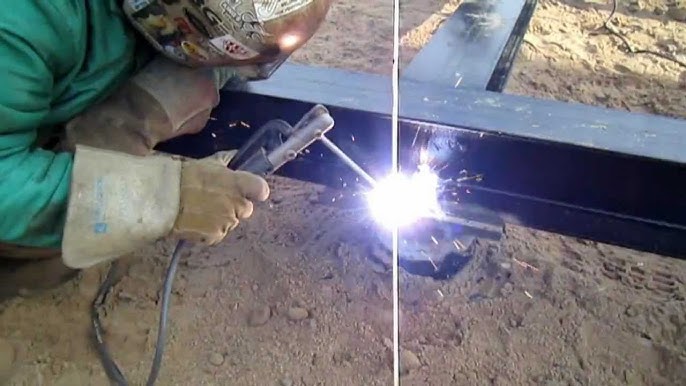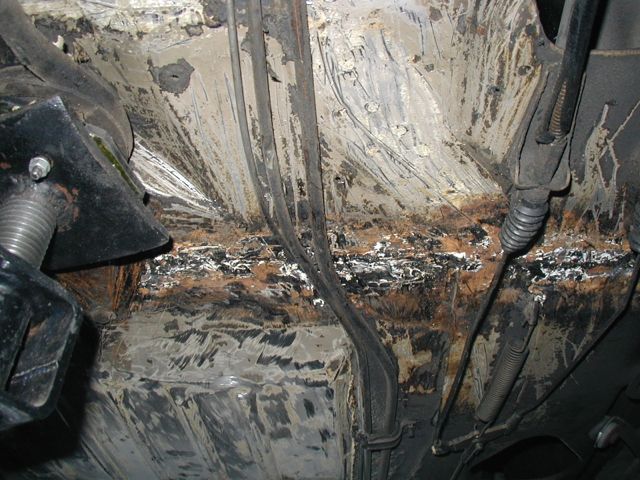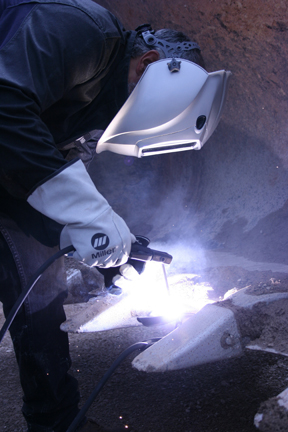Usual Welding Repair Service Issues and Just How to Address Them Effectively
Welding repair services commonly encounter a series of concerns that can endanger the honesty of the end product. Typical issues include inadequate infiltration, porosity, and imbalance, amongst others. Each problem offers one-of-a-kind difficulties that need particular strategies for resolution. Understanding these problems is crucial for welders aiming to improve their abilities and results. This discussion will certainly check out these usual welding fixing issues and effective techniques to resolve them.
Insufficient Infiltration
Inadequate penetration happens when the weld metal fails to totally fuse with the base product, causing weak joints and potential structural failings. This problem frequently originates from not enough heat input, incorrect electrode angle, or inappropriate welding speed. Welders may encounter poor infiltration due to a mistake of the needed specifications for a certain product density or kind. Additionally, contamination on the base product's surface area can hinder efficient bonding, exacerbating the problem. To address inadequate infiltration, welders must assure appropriate settings on their equipment and preserve a clean work surface area. Regular assessment of welds is recommended to determine any type of deficiencies early, enabling for timely corrections and the prevention of compromised structural honesty in bonded settings up.
Porosity
Porosity is a common issue in welded joints that manifests as small gas bubbles entraped within the weld metal. This problem can compromise the stability of the weld, resulting in lowered strength and potential failing under stress. Fabrication. Porosity generally develops from contamination, wetness, or incorrect welding methods, which permit gases to get away right into the liquified weld pool. To address porosity, welders need to guarantee appropriate surface area preparation, keep a clean working setting, and make use of ideal welding parameters. In addition, picking the best filler material and securing gas can mitigate gas entrapment. Regular inspection and screening of welds can help recognize porosity early, ensuring prompt rehabilitative activities are taken, thereby protecting the quality and integrity of the welded framework
Misalignment
Imbalance in welding can arise from numerous elements, consisting of incorrect arrangement and thermal growth. Recognizing the origin is important for effective resolution. A number of improvement techniques are readily available to straighten parts and ensure architectural stability.
Reasons for Imbalance
Welding imbalance often stems from a variety of underlying issues that can endanger architectural honesty. One main reason is improper fit-up of components prior to welding, which can cause spaces and irregular surfaces. Variants in thermal growth during the welding process can additionally cause distortion, particularly if the materials being joined have different coefficients of growth. Furthermore, poor securing and fixturing might fall short to hold parts safely in area, leading to activity during welding. Badly conserved tools, including welding makers and tools, might present incongruities in the weld grain, further adding to misalignment. Driver mistake, stemming from not enough training or experience, can additionally play a substantial role in creating misaligned welds.

Modification Strategies Offered
Resolving imbalance successfully needs a mix of corrective strategies customized to the certain issues available. One usual approach is making use of components or jigs to hold elements in the correct setting during welding, making certain regular positioning. Furthermore, pre-heating the materials can help in reducing distortion and improve fit-up. For considerable misalignment, mechanical realignment strategies, such as utilizing hydraulic jacks or clamps, can be used to remedy the placement prior to welding. Post-weld warmth therapy may also be needed to alleviate anxieties brought on by imbalance. Finally, cautious assessment and adjustment during the configuration stage can protect against misalignment concerns from coming to be significant troubles, advertising a smoother welding procedure and improving general architectural integrity.
Distortion
Distortion is a common challenge in welding that can emerge from various elements, consisting of irregular cooling and heating. Comprehending the root causes of distortion is crucial for carrying out effective prevention techniques. Resolving this concern not only boosts architectural integrity yet also boosts the total top quality of the weld.
Sources of Distortion
When subjected to the intense warmth of welding, products typically undergo adjustments that can bring about distortion. This sensation mainly emerges from thermal expansion and tightening throughout the welding procedure. As the weld area warms up, the product expands; upon cooling, it gets, which can create inner tensions. On top of that, unequal heating across a workpiece can intensify these stresses, leading to warping or flexing. The type of material additionally plays a significant function; steels with varying thermal conductivity and coefficients of development may respond differently, causing unpredictable distortions. Bad joint layout and insufficient fixturing can contribute to misalignment throughout welding, increasing the probability of distortion. Understanding these causes is essential for effective welding repair work and avoidance techniques.
Avoidance Techniques
Reliable avoidance methods for distortion throughout welding concentrate on managing heat input and making certain correct joint design. Keeping a constant warmth input helps to decrease thermal growth and contraction, which can cause distortion. Utilizing methods such as pre-heating the work surface can also minimize the temperature level gradient, promoting consistent home heating. In addition, selecting suitable joint layouts, such as T-joints or lap joints, can enhance stability and decrease stress and anxiety concentrations. Executing appropriate fixturing to safeguard the work surfaces in location even more help in preserving placement during the welding procedure. Ultimately, staggered welding sequences can disperse heat much more evenly, avoiding localized distortion. By using these approaches, welders can significantly reduce the possibility of distortion and boost the total quality of their welds.
Fracturing
Fracturing is a typical issue run into in welding fixings, frequently arising from different factors such as improper air conditioning rates, material selection, or poor joint preparation. The incident of cracks can substantially endanger the stability of the weld, bring about prospective failings throughout procedure. To address this click to read problem, welders have to initially assess the origin triggers, ensuring that materials work and appropriately picked for the particular application. In addition, controlling the cooling rate during the welding procedure is necessary; rapid air conditioning can cause tension and bring about breaking. Appropriate joint layout and prep work likewise add to reducing the threat. Executing these approaches can improve weld top quality and sturdiness, eventually lowering the possibility of cracking in completed weldments.

Incomplete Combination
A significant problem in welding repairs is insufficient fusion, which happens when the weld metal does not effectively bond with the base material or previous weld passes - Montana Mobile Welding and Repair. This issue can cause weaknesses in the joint, possibly jeopardizing the honesty of the bonded framework. Factors adding to insufficient combination consist of inadequate warm input, incorrect welding method, and contamination of the surfaces being joined. To address this problem efficiently, welders need to assure appropriate pre-weld cleaning and surface preparation, along with readjust their welding parameters to attain sufficient penetration and blend. Routine inspection during the welding procedure can likewise aid recognize incomplete fusion early, enabling prompt restorative procedures to enhance the general quality of the weld
Overheating
While welding repair services can boost structural honesty, overheating provides a significant challenge that can result in material degradation. Excessive warmth during welding can alter the mechanical properties of metals, causing minimized toughness, boosted brittleness, and warping. This sensation is particularly vital in high-stress applications where architectural integrity is critical. Determining getting too hot can include aesthetic assessments for discoloration or distortion, in addition to keeping an eye on temperature throughout the welding process. To alleviate the risks connected with getting too hot, welders need to utilize suitable techniques, such as regulating warmth input, adjusting traveling speed, and using appropriate Recommended Site filler products. In addition, implementing pre- and post-weld warm treatments can aid bring back product buildings and boost the general top quality of the fixing, making sure lasting performance and security.
Frequently Asked Concerns
What Are the Usual Signs of a Welding Issue?

How Can I Evaluate My Welds for Top quality?
To check welds for top quality, one can utilize visual inspections, ultrasonic testing, and radiographic techniques. Each technique guarantees structural stability, recognizes defects, and validates adherence to specified criteria, eventually boosting the dependability of the welded joints.
What Security Safety Measures Should I Take While Welding?
When welding, one should focus on safety and security by using proper individual protective devices, making sure proper ventilation, securing combustible materials away, maintaining a tidy work area, and recognizing surroundings to stop mishaps and injuries.
Can I Repair a Weld Without Redesigning the Entire Joint?
Repairing a weld without remodeling the whole joint is possible, relying on the damage (Montana Mobile Welding and Repair Belgrade Welding). Methods such as grinding, adding filler material, or utilizing a welding process can successfully deal with particular problems while protecting the bordering framework
What Tools Are Essential for Reliable Welding Repairs?
Vital devices for efficient welding repair work consist of a welding machine, cord brush, grinder, safety gear, clamps, and filler products. Each device plays a crucial function in making sure high quality and safety and security throughout the repair work process. Porosity commonly develops from contamination, dampness, or improper welding strategies, which allow gases to escape into the molten weld pool. Badly maintained tools, consisting of welding equipments and tools, may introduce disparities in the weld bead, further adding to misalignment. When subjected to the extreme warm of welding, products often undertake adjustments that can lead to distortion. Fracturing is an usual concern come across in welding repairs, typically resulting metal arc from various aspects such as improper cooling prices, product option, or insufficient joint preparation. A substantial issue in welding repair services is incomplete combination, which takes place when the weld steel does not properly bond with the base product or previous weld passes.